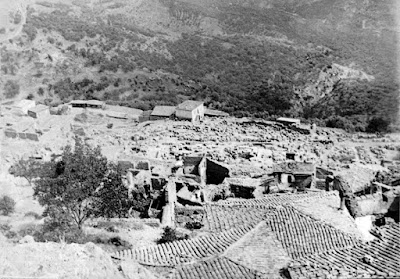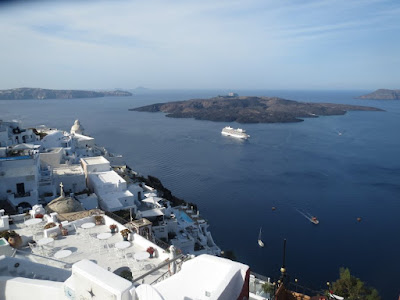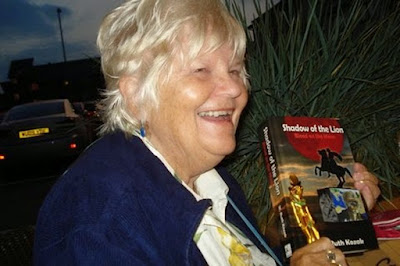Tuesday, October 27, 2015
Friday, October 23, 2015
CIG Excursion to Boiotia and Site & Museum Ticket Prices to Rise
The final stop on the excursion will be the Greek Canadian excavations at Eleon. Professor Brendan Burke (University of Victoria), the Co-Director of the project, will guide the group. After five years of excavation there are two areas with substantial domestic structures dating from Late Helladic IIIB to the end of IIIC. The “Blue Stone” structure is a large rectangular burial monument dating from Late Helladic I. Sondages have revealed Middle Helladic remains below. The most visible feature of the acropolis is a curving wall of polygonal masonry that dates to the late Archaic period. Associated with it are a series of gates that utilize the remains of the Mycenaean wall and gate of the acropolis. There is ample evidence in the form of terracotta figurines and miniature vessels for a shrine or sanctuary somewhere in this area of the site.
The bus for the excursion will leave from the foot of Gennadiou and Vas. Sophias in Kolonaki at 9:00 am sharp. The expected return is around 17:30. It should be noted that for the Eleon visit there is a walk of ca. 100 m upslope over slightly uneven ground. Further, if it has rained recently the ground on the path and at the site may be muddy. Be prepared!
The cost of the excursion (excluding the lunch in Thebes) is 20 € for members of CIG and the Athens Friends’ Association of CIG. For others the cost is 30 €. As the seating on the bus is limited don’t delay in making your reservation by sending an email by Friday, October 30 to ad@cig-icg.gr. For further information: 210.72.23.201 (09.00-13.00 weekdays). We look forward to you joining us!
Price of the Tickets to Greek Archaeological Sites and Museums to Rise
All I seem to write about are references to the economic crisis that has engulfed this country since 2010 and the various efforts and measures that have been implemented to surmount this very difficult situation for Greece. For those of us who live in Greece permanently this is central to most discussions we have and the TV news programs that we watch. The Hellenic Ministry of Culture has been affected in various ways from cuts in its operating budget to fewer archaeologists and guards in the ephoreias and museums. As a result some sites and museums are now operating with reduced opening hours or even remain closed.
The constant search for revenue by the new government in the past month has reached the country’s archaeological sites and museums. This month the Central Archaeological Council recommended to the Minister of Culture to raise the prices of tickets during the tourist high season from April 1st until October 31st for the 30+ most popular sites and museums (whose hours during this period run from 08:00 to 20:00). Thus, the ticket for the Akropolis (and the South Slope Archaeological Park) will go from 12 € to 20 €. The site of Mycenae will rise from 8 € to 12 €. The Minoan palace at Knossos will go from 6 € to 15 €. The National Archaeological Museum and the Herakleion Museum, now 7 €, will go to 10 €. It is reported that for the winter season the prices will be reduced by 50% and there will be free admission on the first Sunday of every month. There has been a proposal as well that those individuals with free entrance passes to sites and museums from the Hellenic Ministry of Culture pay at least 1 € for each entrance.
The increasing numbers of tourists visiting Greece are seen as a deep well for a part of the revenue needed by the state to fulfil its substantial financial requirements under the Memorandum negotiated with the “quartet” this summer.
Cordially,
David Rupp
Director
Tuesday, October 20, 2015
The Fred Winter Collection
Friday, October 16, 2015
The Creation of the Archaeological site at Delphi and the "other" Santorini
The lecture is the first of 2015/2016 Lecture Program of the Syllogos Filon tou Istorikou Archeiou tis Archailogikis Yperesias. The lecture will be held at the Historical Archive Building at Psaromylingou 22 on the cusp between the Kerameikos and the Psyri Districts. The Theseio train station is the closest stop in the Metro system. The public is welcome!
The “other” Santorini
Almost anyone living in Greece, and especially Athens, for the past five years could not have failed to see the devastating effects of the economic crisis brought on to a large part by the high level of public debt, ineffective tax collection, and mediocre political leadership. The economic medicine forced on the country by the then “troika” and now the “institutions” often seems to exacerbate the situation rather than lead the country to renewed growth and prosperity. Greater tourism is often heralded here as the economic driving force that will create the much needed jobs, encourage sought after development and generate the increased tax revenue for the country. The rich and diverse cultural heritages of the country along with the inherent beauty of Greece’s varied natural landscapes and seascapes are frequently argued as what draws tourists to the country. But is “industrial scale tourism” really a long term answer to creating a vibrant, sustainable national economy that safeguards the cultural heritage and the environmental capital of Greece? Are there better alternatives?
Recently my wife and I joined a specialized tour to the island of Santorini where we saw the effects of year-round “industrial-scale tourism” (as the permanent residents call it) on the island’s fragile, unique environment. Even in mid-October Fira and Oia with their repetitious commercialism are overwhelmed with both individuals and large groups while the other regions of the island and their attractions have a different experience. What could be a more sustainable, more culturally focused and more widely distributed forms of tourism? The four interrelated themes of the tour were Greek cuisine utilizing exclusively local and regional agricultural products, Santorini wines and wineries, the production and the processing of traditional local agricultural products, and the rich cultural heritage of the island – archaeological and traditional.What we saw were a series of widely-distributed local nodes – focusing on the cultivation and processing of local agricultural products (fava, Santorini tomatoes, white melitzanes, pistachios, indigenous Assyrtiko, Athiri and Aidani grapes, wild capers, candied fruits, Chloro cheese), wineries and wine tasting (Boutari, Santos, Sigalas, Canava Roussos), the industrial heritage of the island (D. Nomikos cannery), creative cuisine and cooking lessons (Selene, 1800, Vassilios, Krinai, Psaraki), archaeological sites, museums and churches (Akrotiri, ancient Thera, Archaeological Museum, Museum of Prehistoric Thera), folk heritage (Santorini of the Past) and traditional settlements (Pyrgos, Finikia, Megalochori) – that formed a flexible network that lies mostly beyond the sprawl of the two tourist towns on the edge of the caldera.These nodes have been created by individuals, cooperatives and companies with visions for both celebrating the island’s traditional strengths and in preserving them in a sustainable fashion. Other companies have developed to provide tours and transport to these disbursed locations. You can also connect the nodes on your own by following the extensive network of marked trekking trails or by renting a bicycle. In the process they have created jobs (especially for the younger and the older components of the work force and for those who want to remain on the island), they are preserving the fast-disappearing agricultural land, they have made worthy, often unique value-added products for local consumption and for export, and they have provided a holistic context for understanding and appreciating Greek culture – past and contemporary – for the visitors to this country. If this imaginative trend of creating local nodes of interest (beyond the limit of the well-known “sun and sea” mentality) were duplicated on the other islands of the Cyclades then a broader network of small networks would be created. These in turn could be linked to similar local and regional networks in the other diverse geographical regions of Greece. In this way the tourists to the country could be enticed away from just visiting the often overcrowded usual “top 10” attractions. Such a small country, but it has such diversity. The potential for a sustainable economy with these small networks is palpable.With these many interesting possibilities in mind one can now imagine picturesque Santorini as more than a view of the caldera amongst the tourist shops or watching the sunset at Oia with thousands of day trippers from the cruise ships. The rest of Greece can be like this too with imagination, cooperation, effort and support from the state!
Cordially,
David Rupp
Director
Tuesday, October 13, 2015
Friday, October 9, 2015
A "Must See" Temporary Exhibition at the National Archaeological Museum
The ongoing (and never ending?) economic crisis that has befallen Greece has had many ripple effects here. One of them is the significant reduction in the operational budget of the Hellenic Ministry of Culture. One visible manifestation of this is the near absence of special exhibitions mounted at the museums here in Athens. It seems that only foreign museums will have “blockbuster’ Greek art exhibitions. A notable exception to this unfortunate pattern is a recently-opened gem of a temporary exhibition at the National Archaeological Museum (8 September 2015 – 8 October 2016). It is entitled “a dream among splendid ruins…”: Strolling through the Athens of travelers, 17th – 19th Century. This fascinating and eclectic display of 22 original illustrated books, drawings, paintings and other illustrative materials from the 17th through 19th centuries from the library of the Hellenic Parliament is melded effectively with 35 seldom-seen marble sculpture fragments from the National Museum’s ample storerooms which were found in the course of the 18th and 19th centuries around and on the Akropolis mostly.
The items in the exhibition serve to highlight the ancient monuments of the “Golden Age” of Athens and the exotic sights that the wealthy European travelers, products of the Renaissance and the Enlightenment, came to see here on their “Grand Tour”. The exhibition is organized as five broad “imaginary strolls” that the travelers could have taken on the Akropolis and then around the area of the ancient city of Athens. To enhance the sense of atmosphere created by the displays there is a musical soundtrack playing in the background with European compositions from this broad era and transcriptions of traditional Greek folksongs. It ends with a glimpse into how the Hellenic Archaeological Service approached the tasks of organizing the antiquities found by chance and by excavation in the 19th century and then their display in a specially-built National Archaeological Museum. The recreation of one of the late-19th-century display cases of the National Museum with some of the gold and bronze objects from Mycenae indicates how far museology in Greece has come since the creation of the modern Greek state in 1832.
The substantial bilingual (Greek/English) exhibition catalogue is a must purchase at only 12 € (and there is a 30% discount for archaeologists with a free-entrance Museum and Site Pass from the Ministry). The contents cover the rationale for such an exhibition, the image of Athens in modern European visual culture, the background of the five strolls, the museological and museographic designs behind the exhibition, the conservation of antiquities in the exhibition, the sources of the musical accompaniment in the exhibition space and the historical imagery in the Photographic Archive of the National Archaeological Museum. Then there is the Catalogue of all of the items in the exhibition. Each essay is well-researched with full references and a rich bibliography.
This exhibition and its catalogue represents a succinct and stimulating introduction to the topography and monuments of Athens as well as the reasons why increasing numbers of travelers from western European, starting in the 17th century, came to seek the roots of western civilization here. The how and the why exhibitions are mounted is introduced too. In short, one should definitely see the exhibition even if you have no other pressing reason to visit the National Archaeological Museum with its old chestnuts.
If you missed the equally excellent exhibition on the Antikythera mechanism, the remnants of it that are not in the current travelling exhibition are still on view in a room off the entrance foyer of this new exhibition.
So head to the National Archaeological Museum to see this compact and compelling exhibition and then visit one of your favorite galleries to reacquaint yourself with some old friends. Finally, we eagerly await other imaginative exhibitions which rescue artifacts and art from their imprisonment in the storerooms of the museums of Athens.
Cordially,
David Rupp
Director
Tuesday, October 6, 2015
Friday, October 2, 2015
Bravo Dimitri Nakassis!!! Book Presentation for our Friends
Dimitri is well known at the Institute serving as the Co-Director with Professors Scott Gallimore (Wilfrid Laurier University) and Sarah James (University of Colorado at Boulder) of the Western Argolid Regional Project or WARP, one our independent survey permits from the Hellenic Ministry of Culture. In 2014 he gave the Invited Lecture at our Annual Open Meeting on his ground-breaking research into the Linear B tablets found at the Palace of Nestor at Pylos in Messenia. The MacArthur Fellowship will allow him to expand the scope of this investigation to other archives. Further, it will support the project in which he is a lead researcher that is undertaking the high resolution digitalization of all of the known Linear B tablets.
On behalf of the Institute and its members I extend enthusiastic congratulations to Dimitri on this prestigious award! His achievement makes us proud. We look forward to his lecture in the Institute’s Winter/Spring Lecture Program when he will be in Greece as part of his current sabbatical leave.
Book Presentation and Reading
Our first event of the fall for the Athens Association of Friends of the Institute is coming this Wednesday, October 7th at 7:30 PM in our Library. It will take the form of a book presentation and selected readings from the book.
Taking fifteen years to write, Shadow of the Lion: Blood on the Moon is Volume One of an epic story set in the aftermath of the death of Alexander the Great in Babylon in 323 BC and the bloody Wars of Succession. This is W. Ruth Kozak’s debut literary novel which chronicles the journey westward of the newly appointed joint-kings, Alexander’s half-brother Philip Arridaios and his infant son, Iskander (Alexander IV).
W. Ruth Kozak is a Canadian travel journalist with a strong interest in history and archaeology. A frequent traveler, Ruth lived for several years in Greece and instructs classes in travel journalism and creative writing for the Vancouver School Board in British Columbia.
The novel was extensively researched in Greece, with the support of Classical scholars, the Hellenic Ministry of Culture, the Society of Macedonian Studies (Thessaloniki), and the Finnish and Norwegian Institutes in Athens. Further research was undertaken in the Gennadius Library and at the British Library in London.
We look forward to seeing you all again on Wednesday after the long summer hiatus. You’ll have a chance to meet and welcome Sarah and Vicki our new Fellow and new undergraduate intern!
Cordially,
David Rupp
Director





















